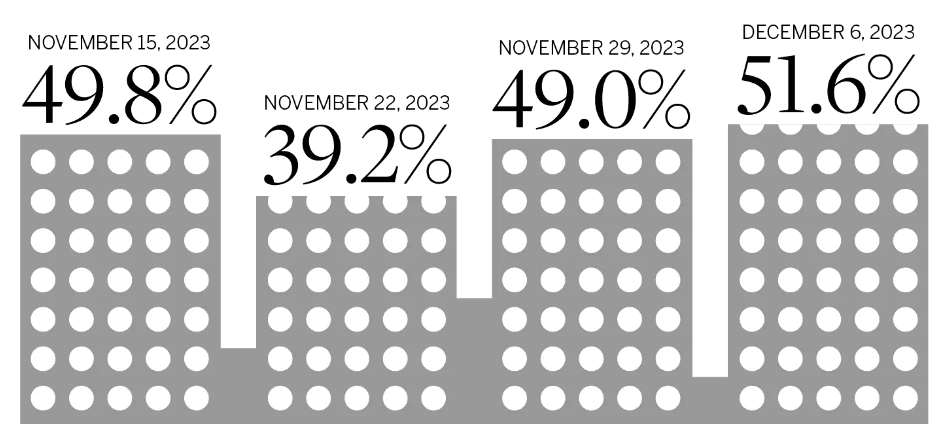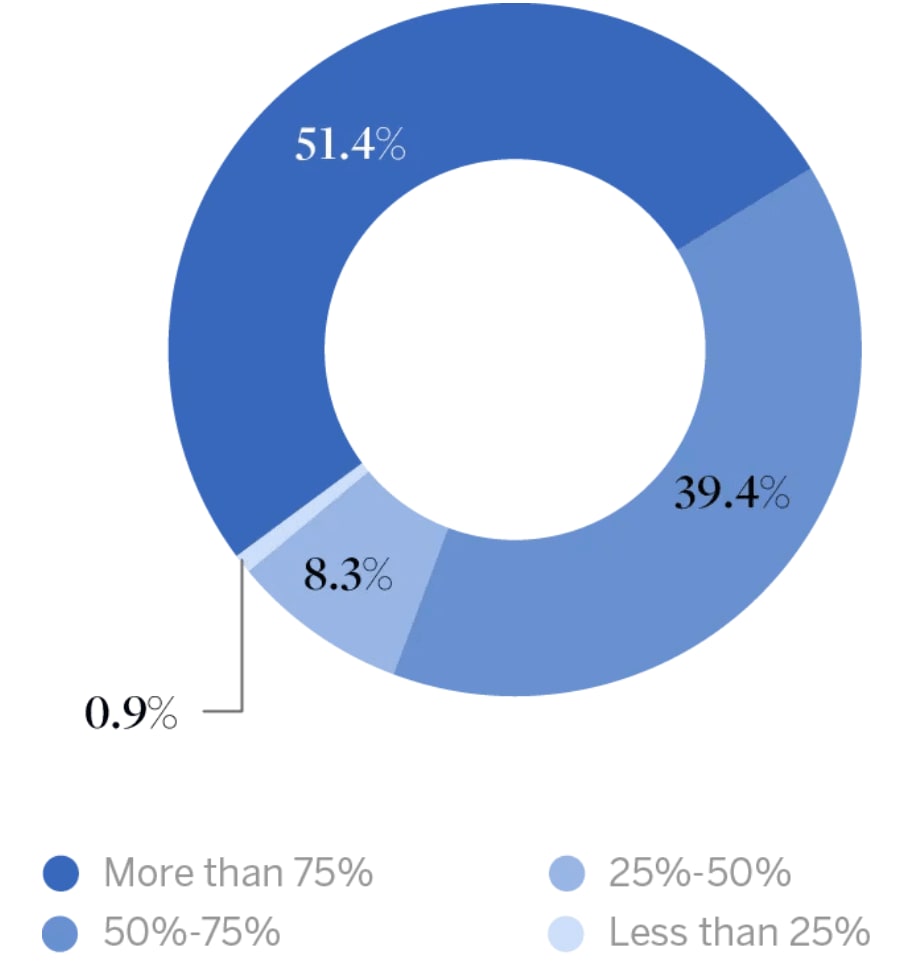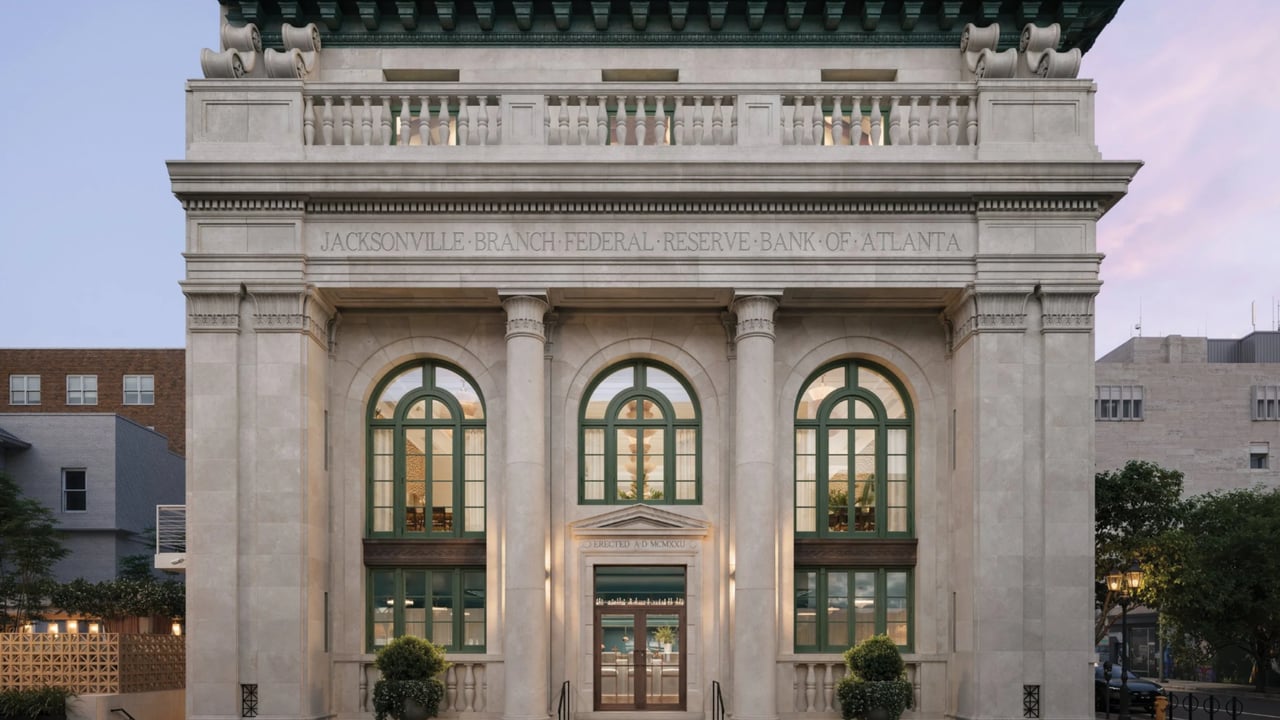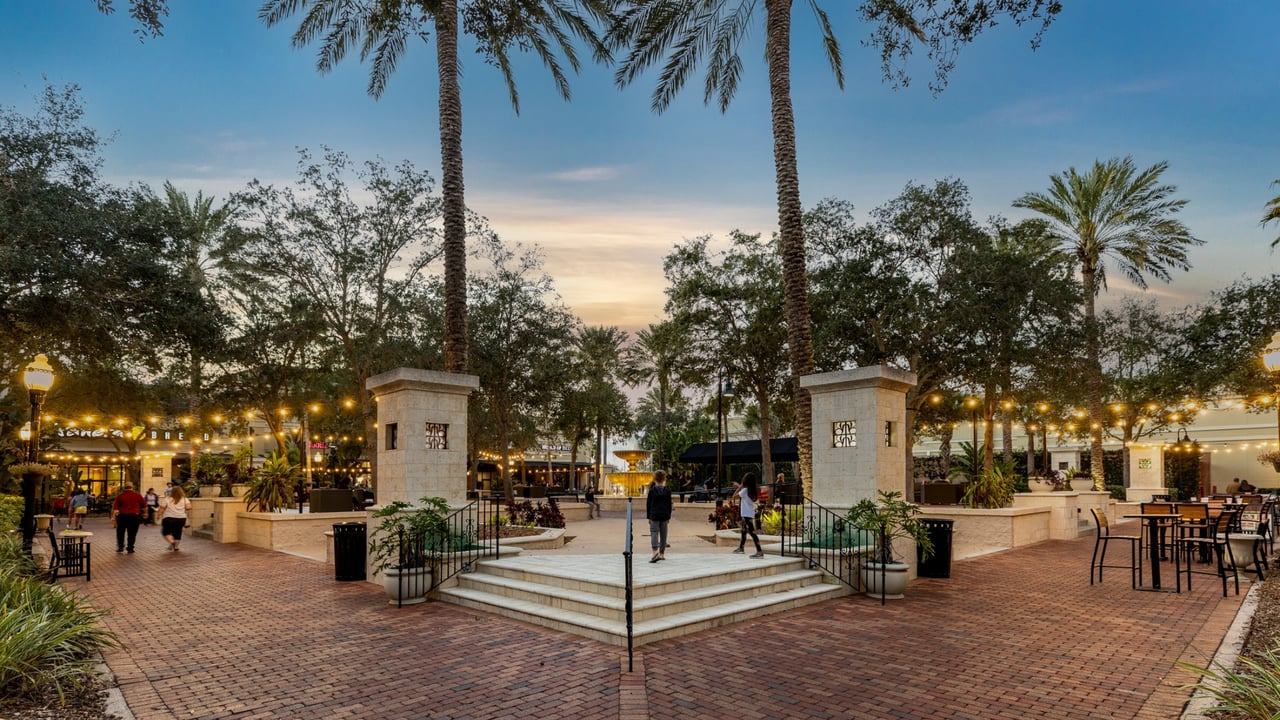Hybrid work arrangements are here to stay. According to data from property technology and security firm Kastle Systems, whose Back to Work Barometer tracks access to offices in top U.S. metro areas, occupancy hovered around 50% in September 2023—dipping as low as 26.2% in cities like New York and San Francisco on Fridays.
The implications are huge for commercial and residential real estate. How will overlapping work and home lives change what homebuyers and residential tenants want? What happens to retail that once served a steady, five-day flow of office workers? As workers untether from offices, what other spaces will serve as workplaces?
To find out, we spoke to Sotheby’s International Realty agents in five locations facing related, but very different, challenges.
“The transformation of the sanctuary that was home into an office has changed how people prioritize what they’re buying, where they’re buying, and how they’re working,” says Joel Schilperoort, broker associate, Sotheby’s International Realty - San Francisco Brokerage in the city’s Marina district. “Pre-Covid, population density didn’t matter. Buyers went from, ‘I want to be in a complete city environment’ to ‘I want the suburbs, parks, outdoor space, and an office at home.’”
As a result, “suburban neighborhoods are more competitive than they’ve ever been, even with high interest rates.”
The hottest suburban area in his region is Marin County, across the Golden Gate Bridge from San Francisco, he says. About 15 miles north of downtown, its affluent towns include Mill Valley, Larkspur, Belvedere, and Corte Madera.
“You definitely see more people at coffee shops” in the suburbs, he says, many of whom are taking meetings, holding conference calls, or dialing into Zoom sessions.
But there hasn’t yet been a re-energizing of the office market in the San Francisco suburbs, he adds. And recent reports have concentrated on artificial intelligence-focused companies giving the city’s faltering commercial real-estate market a boost. (OpenAI, creator of ChatGPT, for one, is headquartered in San Francisco’s Mission District.)
And it appears as though several big-ticket sales during the second half of 2023—including a US$23.5 million off-market deal and a US$17.5 million condo sale, both in Pacific Heights—point to strength in the city’s residential real estate market, too.
Like San Francisco, work from home has buoyed a widening commuter belt around Dublin, Ireland, while continuing to affect fortunes of city retail and food businesses, says David Byrne, managing director, Lisney Sotheby’s International Realty in Dublin.
“There’s been a complete revitalization of commercial activity in suburban locations because of the population influx,” Byrne says. “Locations that were busy on weekends and quiet on weekdays are now humming seven days a week.”
The dominance of telecommuting has shifted the demands from affluent homebuyers in terms of product and location, he adds. “The most sought-after locations used to be near the city, with a new stock of quality Victorian and Georgian homes,” Byrne says.
Back to Work
Occupancy for office buildings based on an average of 10 major metro cities, including: San Francisco, Austin, Chicago, Washington D.C., San Jose, New York, Houston, Los Angeles, Dallas, and Philadelphia.
Source: Kastle.com as of December 2023
“That’s moved to coastal or suburban locations with more space and a garden. There’s a greater emphasis on outdoor space, and typically dedicating a room in the house to become an office. But homes with ample green space also offer opportunities to build ‘timber cabins’ where owners can work. They’re assessing space needs in a completely different way.”
One of the limitations of how far buyers can go from Dublin isn’t traffic or limited services, but Wi-Fi, Byrne says. “There are still some parts of the country where Wi-Fi is poor, which makes working from home challenging,” he says. “It’s changing, but very slowly.”
For tenants, work from home has made “developments with communal working spaces the most sought-after,” Byrne says. “Any communal space in those projects has been adapted to become a workspace. That was not as important pre-Covid. On-site amenities were less important, because tenants would have used them near their offices. Now, they want amenities both at home and to lure them back to the office.”
Back in the U.S., Boston, Massachusetts, like Dublin, saw a dramatic expansion of its commuter belt as a result of work-from-home and hybrid plans.
“What had been a seven-to-10-mile radius expanded a great deal, with some people moving to smaller cities that offer more affordable prices, like Portsmouth, New Hampshire, or Portland, Maine,” says Colleen Barry, CEO, Gibson Sotheby’s International Realty in Boston. “As a result, there has been huge upward pressure on prices in some of those towns. In places like Cape Cod, I saw people from New York who were thrilled to pay US$1 million for a house. There is a shift in perceived value of these areas.”
Prices in Boston held steady, though.
“We’re relatively small, and we have many legs to the stool—schools, medical, technology, finance,” she says. “Even with the exodus to other communities, demand did not fall in the city.”
Rentals have not held up as consistently, as priorities changed for remote workers, she says. “Units with fewer bedrooms are more challenging,” she says. “People are thinking that if this is the workspace, living space, and workout space, they need more flexibility.” Tenants are “not necessarily being drawn to buildings with amenities, but to neighborhoods with amenities.”
“The value of commercial real estate has gone down, a lot,” she says. Suburban office markets have not seen increased demand as a result of remote work, but their communities have. “Areas that for years didn’t have a thriving main street now have one, like Portsmouth, and Portland,” she says. “People who had social amenities in the city want them in their new homes.”
Unlike Boston, a city half its geographic size, Seattle, Washington, relies heavily on the tech sector, and much of the city’s new construction had been “urban campuses” aimed at attracting workers downtown, says Dean Jones, principal and owner, Realogics Sotheby’s International Realty.
After hybrid work arrangements took hold, “the whole walk-to-work component of living downtown became less critical.”
After “hitting bottom” in early 2023 with commercial and retail vacancies that were precipitated by flight to the suburbs, Seattle is rebounding, Jones says. “Apartments downtown were the first to rebound, because rents were low. Condos saw up to 25% price corrections, so they’re coming back because they’re the last bastion of attainable homes. Even remote workers who left are coming back to the city because they’re realizing their dollar goes further.”
Plans to Buy in 2024
The majority of real estate agents from across Sotheby’s International Realty who responded to our survey said their clients plan to buy in 2024.
Source: Sotheby’s International Realty Luxury Outlook 2024 Agent Survey
50%
According to data from property technology and security firm Kastle Systems, whose Back to Work Barometer tracks access to offices in top U.S. metro areas, occupancy hovered around 50% in September 2023.
Empty office buildings present bigger challenges, he says. “Many projects that were purpose-built for the tech boom were delivered as shell and core only, with no interior build-outs. It’s a maximum opportunity for another build-to-suit tenant—which might be another tech company,” Jones says. “The real casualties will be tired class B and C office parks built in the 1970s and now losing tenants to class A at the same price.”
In Westchester County, outside of New York City, suburban office parks are taking a different shape in the wake of the remote-work revolution, according to Ellen Stern, associate broker, Julia B. Fee Sotheby’s International Realty in Rye, New York. “We’re seeing a lot of multiuse spaces that include businesses like fitness facilities that are a destination,” she says.
Like commuter belts around other areas, affluent Westchester is seeing a revitalization of main streets in sought-after towns like Rye, Scarsdale, Larchmont, and Bronxville. “Everything that had been available in the city is now available here,” she says. “We’re starting to mimic urban services with everything from healthful quick-service dining options to a vitamin-drip bar. That’s not particularly suburban.”
But the exodus from New York City has less to do with remote work than with simply needing more space, Stern says. “In most of the families moving here, both parents work. We have a lot of financial-services people, and they’re all back at the office. I don’t see ‘not going back to the office’ as a main driver,” she says. “Even though you’ll have more of three days in the office and two days remote, you’ll see a lot of families where one parent’s hybrid and one is fully back at work.”
Still, home offices are “an essential requirement” for homebuyers, many of whom “were taking Zoom calls in bathrooms during Covid,” Stern says. “Now, I see people taking Zoom calls on their walks.”
New Tech Hubs Around the World
Nowadays, a tech hub can sprout anywhere—sometimes in surprising locations.
Tech-jobs site Dice used job-postings salaries to pinpoint which U.S. cities are new tech-industry hot spots—some boasting double-digit growth year over year.
At the top: Houston, Texas (+45.6% year over year), and Miami, Florida, (+33.6%), along with Phoenix, Arizona (+31.7%), San Diego, California (+29.4%), Charlotte, North Carolina (+27.6%), Boston, Massachusetts (+25.6%), Los Angeles, California (+23.3%), Chicago, Illinois (+21.9%), and Tampa, Florida (+21%), all of which grew more than 20%.
Detroit, Michigan, another fast-growing tech hub, has seen investments from Amazon, Microsoft, and Apple, along with a surge in start-ups and venture capital activity, according to Dice. And Orlando, Florida, better known for theme parks, has doubled down on tech, defense, and training, with a healthy start-up ecosystem.
A slightly different picture emerged from a study by PitchBook-NVCA Venture Monitor, which tracks venture-capital activity. Usurping Silicon Valley’s primary position, Miami, Florida, attracted the most VC money from 2020–2022, followed by Chicago; Denver, Colorado; Philadelphia, Pennsylvania; and Bridgeport, Connecticut.
“Smaller markets have also seen their tech ecosystem grow because of their vibrancy,” according to Kyle Stanford, lead venture capital analyst at PitchBook. “They have strong university systems. They’re places people want to live, where there’s a lot going on.” Nashville, Tennessee, and Minneapolis, Minnesota, are also emerging as smaller-scale tech hubs, he says.
Proximity to heavy-hitting tech hubs like New York and Boston, Massachusetts, has also buoyed cities like Philadelphia and Bridgeport, Stanford says.
In its own report on “Pandemic Trends and Shifts in the Geography of Tech,” the Brookings Institution concluded that Atlanta, Georgia; Dallas, Texas; Denver; Miami and Orlando; San Diego; Kansas City and St. Louis, Missouri; and Salt Lake City, Utah, added a combined 14,000 tech jobs and increased their share of the tech sector—all while “tech-sector employment growth slowed in the biggest, most dominant tech centers” including San Jose and Los Angeles, California, and Boston.
“The next group of places moving up are often anchored by significant Fortune 500 businesses, which means a lot of tech in nontech companies,” says Brookings Institution senior fellow Mark Muro, one of the report’s authors. “These locations tend to have good universities, and great pools of STEM talent.” The ascent of these secondary tech hubs has had “significant” effects on real estate, Muro says.
“Decentralization has really benefited attractive suburbs, exurbs, and small metro areas,” he says. Perhaps recognizing the shifts, President Biden’s administration recently launched a program to designate 31 cities as “Tech Hubs,” to be given federal grants. The locations range from a Baltimore, Maryland, healthcare Tech Hub to a semiconductor-development lab in southern Oklahoma to a nuclear-energy Tech Hub in Idaho and Wyoming.
But Muro cautioned that betting against traditional tech hubs like San Francisco, New York, and Boston is premature. “When a new, early-stage technology comes up, like generative AI, it tends to be highly concentrated in the big, powerful cities,” he says. “You can never count out those command-control centers.”
Internationally, global recruiting firm Oyster ranked the world’s top 10 cities for tech talent, with Vancouver, Canada, at No. 1, followed by Mexico City, Mexico; Manchester, United Kingdom; Lagos, Nigeria; Austin, Texas; Buenos Aires, Argentina; Bengaluru, India; Dublin, Ireland; Barcelona, Spain; and Nairobi, Kenya.
“Rising rents and taxes in megahubs, increased adoption of remote and flexible working, and tech-focused government policy, for example, have pushed talent to newer and emerging tech markets,” according to the report.






